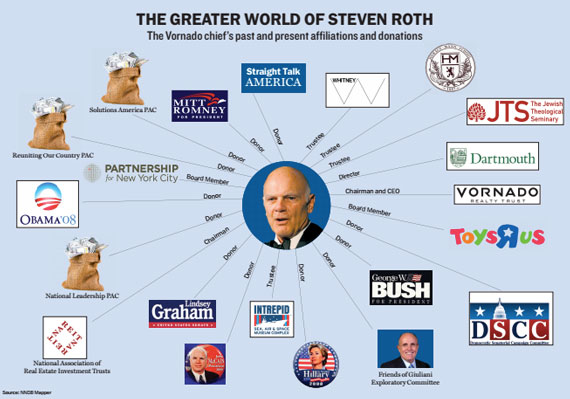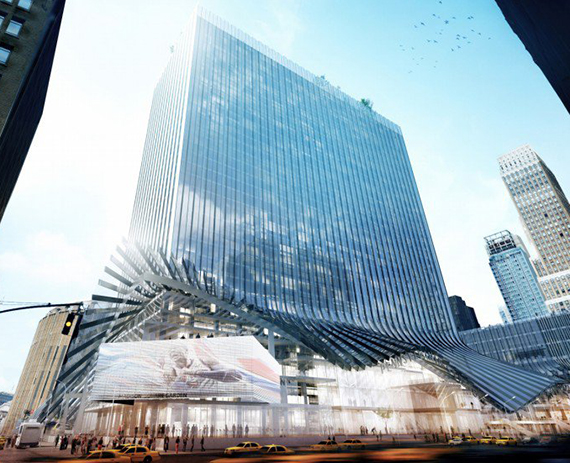From TRD New York’s November 2016 issue: “Don’t be jerky,” Steven Roth told Gary Barnett. “It’s not even close.”
Sitting among other industry titans at Bloomberg LP’s headquarters last spring, Roth was in full troll mode. Barnett had dared to suggest that One57, his cathedral for the 0.1 percent, was better than Roth’s luxury condo tower in the works at 220 Central Park South. And when Jeff Blau spoke about the upcoming condos at Hudson Yards, Roth quipped that his firm, the Related Companies, was “selling to the suckers.” Of his lender at 220 CPS, the Vornado Realty Trust chairman and CEO said: “I’m in the suck-up business to the Bank of China.”
The chiefs of public companies tend to be careful to a fault about what they say in public. Not Roth, who is one of the last in a line of brash hustlers running blue-chip real estate investment trusts — very much in the vein of Sam Zell, whom he’s referred to as a “bald-headed chicken fucker.”
At the same time, Roth has shown remarkable patience in turning Vornado, once a developer of New Jersey industrial properties and strip malls, into the $40 billion behemoth, with more than 30 million square feet of New York City holdings, it is today.
Vornado is now one of the largest owners of commercial property in Manhattan. And there is near-universal acclaim within the industry for the way that Roth has managed the company since Michael Fascitelli — his golden boy and former heir apparent — stepped down as CEO in 2013. The REIT made good on its promise to simplify its portfolio, shedding some of its troublesome fringe investments and doubling down on its prime New York retail holdings.
Vornado’s discipline has given it a fortified balance sheet that now allows it to make transformative bets, including the repositioning of 8 million square feet of office space in Penn Plaza, the $1.6 billion redevelopment of Moynihan Station and 220 CPS, the luxury market’s new prom queen.

A rendering of 220 Central Park South in Midtown (credit: Vornado)
Roth has championed the bulk of those initiatives, and his power at the company is absolute.
“He runs his company as if he owned it all, and his shareholders benefit from that,” Richard LeFrak, CEO of the LeFrak Organization and a close friend of Roth’s, told The Real Deal.
But the Vornado chief, who is now pushing 75, has yet to announce a clear successor — a glaring lack of transparency for a public company with an aging CEO. This makes some Vornado shareholders nervous about the REIT’s fate when he finally calls it quits. Will he leave a void that’s impossible to fill?
“It’s akin to the Grateful Dead,” said Alexander Goldfarb, an analyst at investment bank Sandler O’Neill. “No one wants to see the warm-up band.”
What makes the succession issue particularly grating for the REIT’s shareholders is that the many of Vornado’s biggest competitors appear to have figured it out.
Stephen Green, founder of SL Green Realty Corp., brought in Marc Holliday as the firm’s chief investment officer in 1998, and Holliday, who’s 50, has been its CEO since 2004. His second-in-command, Andrew Mathias, is in his mid-40s.
Meanwhile, Boston Properties’ founder, Mort Zuckerman, named Owen Thomas, a relative outsider, CEO in 2013. Thomas, who came to the REIT from Lehman Brothers Holdings — where he helped the underwater firm unravel its real estate assets — is 54. Related’s Blau, who started at the firm in the early 1990s and became its second CEO in 2012, is 48.
“Some companies will choose to be very upfront with it, and some companies will choose to keep it in the dark,” said John Guinee, a REIT analyst at financial services firm Stifel, Nicolaus & Co. “Usually what happens is, if they think they need to go outside the firm and hire an executive recruiter, then they go public with it. But in other cases, if they think that the candidate is internal, then they will keep it hush-hush.”
Greedy No. 1
But Roth has been known to pull rabbits out of his hat before.
Back in 2006, he had just acquired a prime retail site at 1540 Broadway, in a $260 million, all-cash deal. But Virgin Megastores had a 200-year lease in place, at 15 percent of market value. Unless Virgin left, the deal was a dud.
“We went upon a two-year mission to buy them out, and we flunked,” Roth recalled during an April 2011 quarterly luncheon hosted by the Real Estate Board of New York. “What we eventually did was we teamed up with Related, who had a similar situation in Union Square, and we bought the whole damn Virgin Record company operation in the United States, 20-some odd stores.”
He then pointed to a chuckling Stephen Ross, sitting next to him, and said: “Just so Greedy Number 1 could get his hands on it, and Greedy Number 2 could get that — and it worked!”
When reminded of the story last month, Ross laughed. “I love Steve Roth,” the Related chairman said, “[but] he’s greedier.”
Acquiring a company for its underlying real estate was a textbook move for the Vornado chief.
Born in Brooklyn to a father who made children’s dresses, Roth attended DeWitt Clinton High School in the Bronx, whose alums include Bill Zeckendorf and Lewis Rudin. He got his start in real estate in the 1970s, building industrial properties in the New Jersey Meadowlands. But what made him a real player was buying a controlling interest in the Alexander’s department store chain in the 1990s.
“Alexander’s had a very big and important store in Paramus,” Roth told Crain’s last year. “And I’m sitting there and I’m driving past it and my wife goes, ‘If you’re so smart, why don’t you buy that?’ The next day I bought my first shares of stock in that company. The real estate was worth many multiples of what the retail business was, and the rest is history.”

Michael Fascitelli
While buying out the companies that stood in his way, Roth acquired top talent, too. In 1996, he convinced Fascitelli, then a Goldman Sachs hotshot, to come over to Vornado as president with a compensation package of $50 million, unheard of at the time in real estate. Kenneth Patton, a professor at NYU’s Schack Institute of Real Estate and a former REBNY president, said recruiting Fascitelli was Roth’s signal to his investors and the industry that he was serious.
“With that hire, he was saying: ‘We’re going to be unsentimental. Not good ol’ boys, but young nasty boys who’ll do fucking things the way we gotta do it,’” Patton explained.
Roth and Fascitelli, who the New York Post crowned the “Gangstas of Brick,” matched each other for swagger and chutzpah and went after the biggest assets. In 1997, Vornado acquired Bernard Mendik’s Midtown office portfolio in a $654 million deal, a transaction that the research firm Green Street Advisors said was “among the best M&A deals in REIT history.”
They were also the front-runners to take over the World Trade Center site in 2001, but pulled out of the bid at the eleventh hour, and Larry Silverstein moved in.
In 2007, Blackstone Group had a deal in place to purchase Zell’s Equity Office Properties for about $48.50 a share or $36 billion — at the time the largest-ever leveraged buyout. When Zell solicited rival bids, Roth wrote him a couplet: “Roses are red, violets are blue. I love you Sam, our bid is 52.”
The rhyme set off an intense bidding war between Blackstone and Vornado, in which Blackstone eventually prevailed with a $39 billion offer. It was a career-defining moment for Jonathan Gray, Blackstone’s head of real estate, who said his firm expects to triple its investors’ money in the deal.
“It was like playing basketball in your backyard with your brother,” Gray told TRD of going up against Roth. “You want to win.”
Roth and a Vornado spokesperson declined several requests to comment for this story.
The second coming
Fascitelli’s last few years at the firm yielded mixed results.
The REIT took huge losses on its bets on Toys “R” Us and J.C. Penney, but he was still widely popular and seen as the man to lead Vornado into the next generation. His departure in 2013 was viewed as a major setback, with a Green Street report at the time describing it as a “succession failure.”
Vornado has always played by its own rules. It refused to hold quarterly earnings call until 2012, a notably opaque move for a publicly traded company, and even when announcing major deals, it rarely provides commentary.
But Roth was forced to address Fascitelli’s exit. In a May 2013 earnings call, he assured investors that the REIT was working on a succession plan.
“I’m 71.5 and it’s not appropriate for me to be the head of this company for another 10 years. It’s just not appropriate,” he said.
But he has barely addressed the issue since then — at least publicly.

Goldfarb compared it to the Coca-Cola recipe, calling Roth’s next successor the “greatest mystery in the history of the world.”
LeFrak, who’s 71, said Roth would figure it out when the time was right.
“If Steve felt for one minute that he couldn’t be really effective, he would do something about it,” he said.
Even if Roth has failed to ease investor concerns about his successor, he has managed to reinvent the company he founded. Since Fascitelli left Vornado, the REIT disposed of several office properties, including 1740 Broadway, 866 UN Plaza and 20 Broad Street. It also exited its stake in J.C. Penney, turned its mall portfolio into a separate REIT, sold off major commercial properties in Los Angeles, and spun off its $6 billion Washington, D.C., portfolio.
Roth decided to focus on core Manhattan, where 69 percent of Vornado’s portfolio is now located, he said in an April letter to shareholders. In particular, the firm bet big on high-end retail, buying $1.3 billion worth of assets since 2013, according to Real Capital Analytics, including a $700 million deal for the St. Regis retail condo in partnership with Crown Acquisitions.
Vornado now controls 20 percent of Upper Fifth Avenue’s retail frontage, including flagship stores for Victoria’s Secret, Salvatore Ferragamo, Harry Winston and Massimo Dutti. That stretch has become the world’s priciest shopping location, according to Cushman & Wakefield, with average rents north of $3,500 per square foot. And though street retail represents just 9 percent (2.6 million square feet) of Vornado’s total Manhattan holdings, it generates a third of the New York division’s earnings before interest, taxes and depreciation, Roth said in the April letter.
Many in the industry, including Roth, say Manhattan’s retail market is undergoing a correction, and landlords stubbornly holding out for top-dollar tenants may find themselves exposed.
“We’re not in a hope business, we’re in the realistic business, and I believe rents have gotten to the point where they’re too high,” Roth told investors on an August earnings call.
The REIT, however, is not sitting on much vacant space, and observers say it never lost its head.
“Vornado never overpaid for anything,” said Ron Cohen, a vice chairman of capital markets at JLL. Though landlords might have to accept lower rents for a time, street retail as an asset class remains attractive, he noted.
Forbes pegs Roth’s net worth at $1 billion. His compensation between 2012 and 2015 totaled $35 million, according to Vornado’s public filings. Last year’s figure included $261,724 for a car and driver (sources said driving is one of the few things Roth sucks at).
And with so much money in the bank, the Vornado chief could keep the trains running and leave the big development work for his successor. But several in the know said that’s not his style.
West Side story
Vornado’s “big Kahuna,” Roth said earlier this year, is the repositioning of its Penn Plaza portfolio. Through stealth assemblage plays over the years, the company now controls more than 9 million square feet of office and retail space in the gritty shopping district. Penn Plaza has recently begun to shake off its rusty brand, in part due to the emergence of Midtown South as a tech tenant haven and the rise of Hudson Yards.
The REIT will soon begin renovations of its two major towers next door to Penn Station — One and Two Penn Plaza — both dated office skyscrapers that it plans to completely redesign and connect together, forming a 4.2 million-square-foot mega complex.
Roth recently told investors he hopes to push office rents in his Penn Plaza buildings from the mid-$50s per foot up into the $80s, more on par with new developments two blocks west at Hudson Yards. And much of the redesign, judging by how Vornado executives have described it on an earnings call, seems set on just that: making the buildings look more like their sprightlier Far West Side neighbors.
In March, Danish starchitect Bjarke Ingels released renderings for the new 2 Penn Plaza, a glass-and-steel tower with an undulating canopy at its base inspired by the iconic photograph of Marilyn Monroe posing in a white dress atop a blowing subway grate.

Two Penn Plaza (credit: Bjarke Ingels Group via Yimby)
Sprucing up the Penn Plaza district is something Vornado has been obsessed with for years. More than a decade ago, Vornado and Related were tapped to redevelop the Farley Post Office into a train hall. The partners turned around and proposed something bolder: a $14 billion redevelopment that would have also transplanted Madison Square Garden across the street and replaced it with two skyscrapers, one taller than the Empire State building, and ten million square feet of office space. Then, in 2008, Gov. Eliot Spitzer resigned from office in the wake of his prostitution scandal, and plans for the new station and stadium were shelved.
“It just broke our hearts,” Roth said at a Columbia University talk in 2010. “Every time you go into Penn Station you should be a little bitter. Spit on the floor.”
By early 2016, Gov. Andrew Cuomo had pushed Vornado and Related out of the project altogether. But this September, Cuomo brought them back in the fold for a scaled-down version of the plan. In collaboration with the construction firm Skanska, the two developers will transform the Beaux Arts-style Farley Post Office into a train hall for the Long Island Rail Road, adding hundreds of thousands of square feet of commercial space along the way. The partners are expected to invest $600 million in the $1.6 billion project, which is slated for completion by 2020.
“We’re at the size now where [Roth] doesn’t need me and I don’t need him,” Related’s Ross told TRD in October. “But when we do something we do it because it works for both of us. And the fact is, we trust each other and we don’t let ego stand in the way of doing something, because certainly we both have the size and scale to do anything.”
A modernized Penn Station would be a boon to Vornado’s Penn Plaza bets. But observers question whether it could ever compete for top-tier tenants with Hudson Yards, which has signed the likes of L’Oreal, SAP, KKR and Time Warner.
“New product will always trade for a premium over existing product,” said JLL’s Rob Martin, who helped broker the Foot Locker flagship’s move to Vornado’s 330 West 34th Street. “But given the location, if [Roth] is able to modernize the buildings, he’ll be able to get a premium. Will it be on par with new construction? The market will tell.”
“15 CPW on steroids”
At the Bloomberg event last spring, Roth spoke candidly about why residential development isn’t his thing. He gestured upstairs to the One Beacon Court condos that Vornado developed above Bloomberg’s headquarters in 2005.
“I sold an apartment to a famous person for $24 million in this building a dozen years ago,” he said, alluding to SAC Capital’s Steve Cohen. “He has it on the market now for $85 million. I hate that!”
After completing One Beacon, Roth avoided residential condo construction for years. But 220 CPS — a site the REIT had entered as a lender — was an opportunity too lucrative to pass on. Vornado took control of the site after the owner got mired in financial troubles, and then kept assembling parcels for the luxury condo tower.
But to make it happen, Roth had to go up against Barnett’s Extell Development, which controlled a garage right under a key piece of land. It took two years before Barnett agreed to give up his lease, at which time he also sold Vornado a neighboring lot at 225 West 58th Street, plus additional air rights, for a total of $194 million.
“It was a big game of real estate chess, in which both sides had something that the other wanted — and a lot of value was at stake,” a source close to Vornado said on the condition of anonymity.
With full control of his coveted site and his low basis in the land, Roth decided to go all-out and develop a building that would be, in his words, “at the tippy top of the luxury market.”
In September 2015, the REIT upped its financing from the Bank of China on 220 CPS from $600 million to $950 million. The following month, Roth said Vornado was spending an extraordinary $3,500 per square foot on hard, soft and financial costs to develop the Robert A.M. Stern-designed tower.
There’s a special affection developers feel for their glitziest condo towers. Harry Macklowe is said to obsess over every small detail of 432 Park Avenue, the skinny supertall he regards as “the culmination” of his career. Arthur Zeckendorf will talk about 520 Park Avenue as though he were describing his favorite son. Roth, sources said, goes even further.
“He’s building this building as if he were going to live in every single apartment,” said Corcoran Group CEO Pam Liebman, whose new development arm, Corcoran Sunshine, is handling sales at the project.
Louise Sunshine, who was involved in pre-development and is consulting on the project until the end of this year, said Roth is “absolutely involved in every strategic decision.”
“He’s equally good at coping with numbers as he is sitting down with renderings and designing a living room,” she added.
Even Barnett had praise for his rival, saying 220 CPS’ success proves that despite the perception that the luxury condo market is doomed, the right product can still command big bucks. Roth’s project is “15 Central Park West on steroids,” Barnett told TRD in a recent interview.
The project has a total projected sellout of $3.17 billion for its 87 units, and last November, Vornado announced it had sold $1.1 billion worth of units in just six weeks. Roth has since refused to update the REIT’s shareholders on sales, saying the outsized media attention on the project could be damaging.
Personal politics
In 2011, Roth and his wife, Daryl, a veteran Broadway producer, donated money to three Republican state senators who were supporting same-sex marriage in New York.
“My son is gay and happily planning to marry soon,” Daryl told the New York Times in January 2012. That September, their son, Jordan, walked down the aisle with his longtime boyfriend, Richie Jackson.
A tuxedo-clad Roth gave a memorable toast at the wedding, held at the Al Hirschfeld Theatre on West 45th Street. He told Jordan: “You are complicated and can be difficult, but all the great ones are. My son, I want you to know, you are perfect in Mom and Dad’s eyes.”
The party then moved to Roseland, and included such guests as Barbara Walters, CBS’ Leslie Moonves, Goldman Sachs’ Blankfein and Tyra Banks. Also in attendance: Donald Trump.
Trump and Roth are partners on a skyscraper at 1290 Sixth Avenue, and have been good friends for years. Both men, sources said, are vicious negotiators and share an extreme arrogance.
But Roth’s support of Trump’s presidential run, a campaign in which he has proposed overturning same-sex marriage, took many by surprise.
Trump even gave Roth a special shout-out in his New York primary victory speech, calling the Vornado chief “my man.” And in August, the Trump campaign announced that Roth would be part of its economic advisory committee, a cadre that includes LeFrak, Vector Group’s Howard Lorber, and Colony Capital’s Tom Barrack.

Donald Trump
While few in the real estate industry reacted out loud, an executive at a rival developer said, “it was very hard to take [Roth] seriously on this Trump thing.”
It was left to playwright and gay rights activist Larry Kramer to call Roth out.
“I don’t know why but I was incredibly shocked and disappointed when it was announced that you had become one of Donald Trump’s billionaire brain trust,” Kramer wrote in an open letter to Roth on Facebook. “I could not believe that you could support a candidate, a vice-president, and a party that threatens many of the things that you hold most dear.”
For his part, Roth seems to have distanced himself from the Trump campaign. Federal election filings show he gave no money to the Republican candidate since Trump announced his bid last year, in contrast to Roth’s previous donations to Barack Obama, John McCain, Mitt Romney, and Hillary Clinton, among other politicians.
When asked about his role in Trump’s campaign in September, Roth was in no mood to talk about it. “I have nothing to say about the campaign, and I don’t spend any time on it,” he said at a conference hosted by Bank of America Merrill Lynch.
After the Tornado
Although Roth often seems like a permanent fixture at the company, observers said they see several veteran Vornado executives as contenders for the CEO role.
David Greenbaum, who runs the REIT’s New York division and has been with Vornado since 1997, is one, though several in the know said his personality could not be more different than Roth’s.
“He’s a phenomenal, brilliant guy,” said JLL’s Cohen of Greenbaum. But he’s “one of those mechanics that doesn’t come out of the garage.”
Roth, in contrast, is all rakish charm — an effusive, affectionate type who inspires tremendous loyalty. Corcoran’s Liebman recalled being on the driving range at the Miami golf club La Gorce right next to Goldman Sachs’ Lloyd Blankfein. Up strutted Roth, who bellowed: “Who do I say hello to, the money or the beauty? I’m gonna go with Pam!”
One other potential successor being discussed, according to sources, is Michael Franco, Vornado’s chief investment officer. Franco joined the REIT in 2010 from Morgan Stanley, where he was co-head of acquisitions and capital markets.
Roth could also opt to go outside the firm for his pick, sources said, though no clear outside contender has emerged.
Analysts said it was likely Roth has a plan in place, but doesn’t see the need to disclose it yet.
Sandler O’ Neill’s Goldfarb pointed to Boston Properties, whose appointment of Thomas came as a surprise. Many investors and analysts, he said, were expecting the firm to name Douglas Linde its president.
Blackstone’s Gray, who is 46 and considered one of the front-runners to become the firm’s next CEO once 69-year-old Stephen Schwarzman retires, said he expects Roth to make a smooth transition.
“Betting against Steve Roth,” Gray said, “is not a good way to go.”
